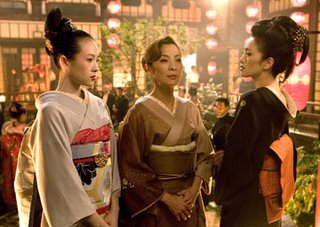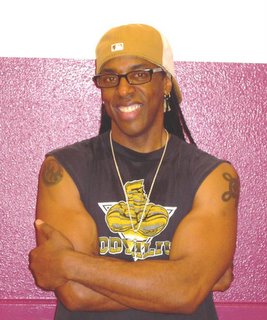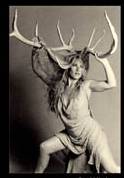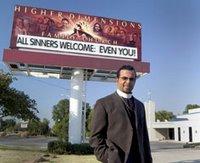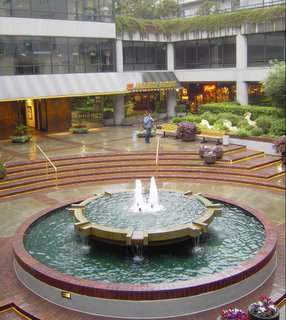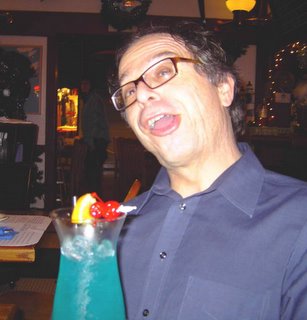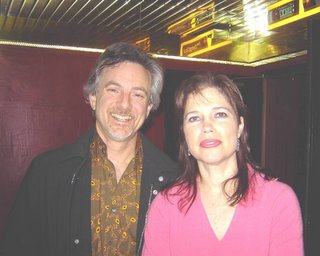 "Ballets Russes" - The Movie
"Ballets Russes" - The Movie
Look who was at the 4:00 p.m. Saturday screening of
"Ballets Russes" at the Opera Cinema in San Francisco: Dan Geller and Dayna Goldfine, the filmmakers who made the documentary film! What a treat! The audience was able to express its great appreciation to them with immediate directness! (There is a good user comment at
imdb.com)
After the screening, Goldfine and Geller hosted a Question-and-Answer session regarding the movie. Even though the audience was small (15 or 20), the audience was unusually well-informed and enthusiastic about what they had just seen.
I was curious what had initiated this project. Goldfine described an event put together by ballet fans in New Orleans in the late 90's (whose own ballet company had just expired), to bring together the veterans of the Ballet Russe de Monte Carlo, some of whom hadn't seen each other in nearly forty years. A colleague named Mark Hawk alerted Geller and Goldfine that this was going to be a unique event, and that someone with their filmmaking talents HAD to be there to film it (they had won an award at the Sundance Festival for "Isadora Duncan: Movement of the Soul" in 1988). Starting there, with all the revived personal contacts and refreshed memories, the project began moving forward, but there was still the time element to consider, since many of the dancers were already in their eighties and nineties. (Still, it begs the question of how Mark Hawk heard of the New Orleans meeting).
Goldfine described a worry she had at the start of the project regarding whether the dance veterans would be able to carry the burden of the documentary. Sure, in their heyday, the dancers had been major stars, but today, they were in advanced age. Would the dancers prove to be too feeble, or too dull, or too unfocused to be - interesting?
This worry proved to be completely unfounded. They might be octogenarians, sure, but the dancers of the Ballet Russe were some of the most dramatic, self-possessed, fierce performers the world had ever seen, and that fire still burned!
Reading some initial reviews of the film, I had formed the erroneous impression that the narrative thrust of the film would be something like: 'plucky group of Russian expatriates in Paris get ambitious, and conquer the world'. That approach couldn't work, though, because there were so many different dancers, who joined in different places and at different times, sometimes under radically-different circumstances. Also, most of the dancers didn't join as principals or directors. Instead, they were chosen at a young age (sometimes shockingly young, like 14-year-old Yvonne Chouteau). The dancers were swept up in a grand adventure: like joining the circus that arrived in town.
Some of the stories are amazing. To me, the most touching story was by Miguel Terekhov. Terekhov informed his father that he he wanted to join de Basil's company (which had been performing in Terekhov's hometown of Montevideo, Uruguay), but his father did NOT approve (and NOT for any of the obvious reasons!)
Plus, all the beautiful, beautiful dancing!
Editing the film proved a major headache. They had twenty, or so, major characters who could not be ignored: the voluble and indefatigable Frederic Franklin, the amiable Mark Platt, the strong-willed Mia Slavenska, the unapproachable Dame Alicia Markova, the alert Nini Theilade, etc., etc. It was almost impossible to weave a workable storyline for use in a film with such a large number of interesting personalities, particularly when there was also a complicated story; a story that starts with the de Basil/Blum partnership in 1931, the big split, the best of Massine's work, the war years in North and South Americas, the return of Balanchine, the temptations of Hollywood, and the agony of what amounted to senescence in the late 1950's and early 60's.
The approach Goldfine and Geller settled on was to place the burden of the complicated narrative onto a female narrator, who told the story almost as a fairytale. The dancers then told their individual stories within that framework. In that way, when a complicated event had to be explained, the narrator could do it, with maps and other visual aids, just as efficiently as possible.
It was so much fun seeing George Zoritch on film. There were touching scenes of Zoritch talking and dancing with former partner and famous ballerina Nathalie Krassovska. Very charming!
9The women dancers of the Ballet Russe, some of the most discerning and beautiful women in the world, were unanimous in their opinion of Zoritch. Their testimony:
Maria Tallchief:
George Zoritch. Oh, oh, oh, he was so good looking! He was the best-looking man I ever saw in my life! Tall and thin; planes of his face, and his beautiful figure. Thin waist, wide shoulders, long legs. Well, he was just - perfection!
Irina Baronova(?):
He was very handsome, with the most wonderful body.
Tamara Tchinerova Finch:
I think he was really born to be a dancer.
Nathalie Krassovska:
I think he was wonderful line, wonderful style. We danced it at the theater.
And they were right of course! When you look at the
pictures of Zoritch when he was in his prime, the only comparison that comes to mind is Classical Greek sculpture.
I took my first, clumsy ballet classes with Zoritch in 1982 at the University of Arizona. Under his good-humored tutelage, even as a neophyte, you came immediately to love dance, and to respect dance tradition. I knew that Zoritch must have some very interesting stories, as also must his fellow dancers. We must all be deeply grateful that Goldfine and Geller, and their colleagues, also saw the possibilities here.
9I was very, very pleased with the film! See it if you can, and by all means, support the theaters that take a risk on this film! Goldfine and Geller said that the DVD of the documentary will be coming out around September/October 2006, and will feature much unused footage.
